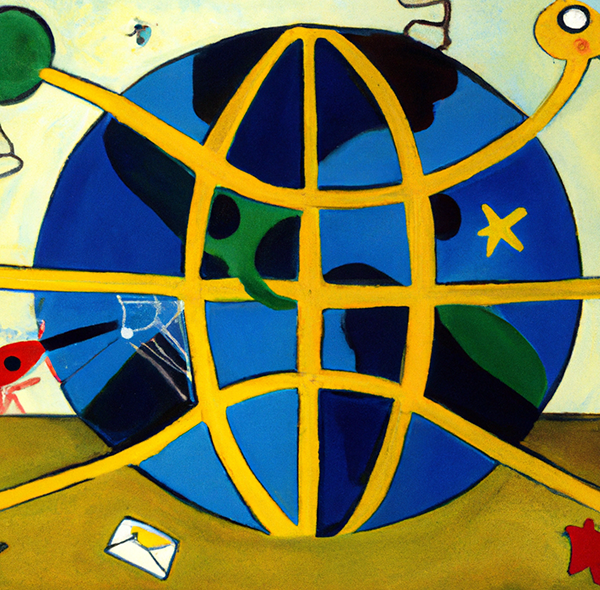
Call to Snaction
This ran in our Newsfeed yesterday, but we thought it was very cool and worth calling out. Three students at UW-Stout developed a prototype of a new kind of packaging for Pringles potato chips. As part of a competition sponsored by Kellanova—a division of Kellogg’s—and the Packaging Association of Canada, students were tasked with redesign the iconic potato chip can in a way that improves “the Pringles snacking experience.”
The winning team—Lukas David, Ethan Myers, and Zach Hoffmire—beat out eight other teams with a design that resembled the classic Pringles can but was more user and environmentally friendly.

From left, professors Min DeGruson and Kate Liu and students Zach Hoffmire, Lukas David, and Ethan Myers.
The final design was the product of an exhaustive research process outside of classes in summer 2023. Myers and David brainstormed nearly 100 ideas, working through them one by one using various criteria and a design rating system.
The final choice was a nine-layer, food-safe structure, easily moldable, with precise amounts of plastic in various locations. They created a 3D model, 3D-printed the final design in a lab and filled it with Pringles for user testing. Everything worked.
One doesn’t normally think of potato chips in terms of accessibility, but Pringles cans can be a little user-unfriendly, although we tend to think of it as more diet-friendly if you can’t get the chips out of the can. Still:
Entries also had to address inclusivity and accessibility for users. Myers and David sought feedback from senior citizens and people with disabilities, including conducting a survey at DisFest in Chicago. The tool that can be used to get the chips out of the can helps address accessibility and general usability.
So the new design boasted:
- An oblong-shaped tube that mirrored the shape of the chip, which stabilizes the product and prevents broken chips.
- Recyclable plastic. (The traditional can is not recyclable.)
- A “peel and reseal tab” on the front of the can, providing better access.
- A new lid that incorporates a tool that pushes remaining chips to the top, of the can.
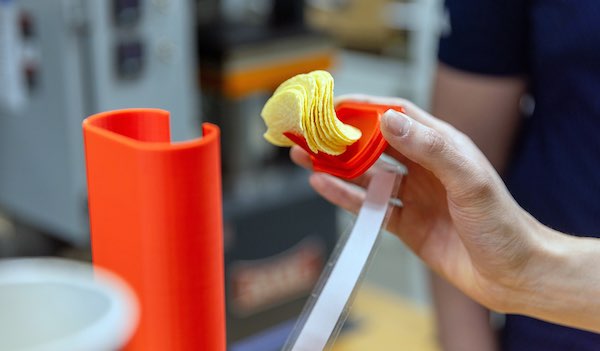
No word yet on whether Kellogg’s plans to use the new design.
Beyond the Cover
Via Print magazine, experimental books are thriving, and a unique traveling exhibition in Italy is highlighting a cross-section of them.
Oggetto Libro (“Book Object”) V Biennale Internazionale del Libro d’Artista is organized by the Milanese SBLU spazioalbellou nonprofit under the direction of Susanna Vallebona. This year, book artist Aguinaldo Perrone is bringing the show to southern Italy at the Academy of Fine Arts of Lecce. The next stop will debut at the Biblio-museum Center of the Puglia Region. Then, on to Santa Maria della Scala in Siena.
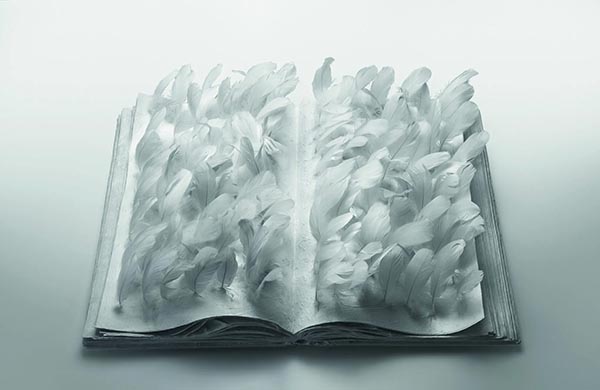
Aguinaldo Perrone
What, you don’t read feather?
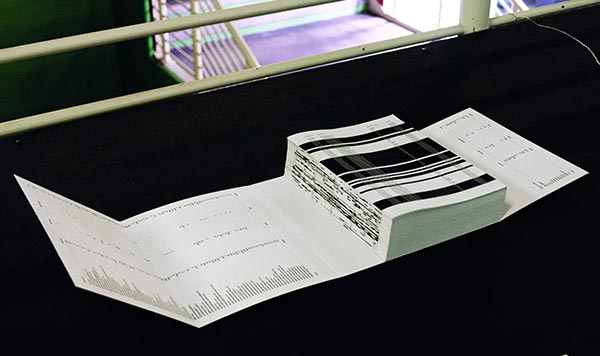
Andrea Benedetto
To be considered worthy of inclusion in this exhibition, “the selected objects must have unique characteristics and must not be unpublished,” Perrone recently told me. “They also must have a narrative structure, with a high technical quality that guarantees the perfect packaging of the book. And they must be evocative of their content, capable of communicating it even with just one page. That is, capable of revealing or making people imagine their intent, guaranteeing the concept of a narrative that lasts over time.”
If you happen to be in Italy, check it out. More examples at Print.
What’s In a Name?
Have you ever wondered what your state or city/town name means? Well, via Laughing Squid, WordTips compiled the literal meaning of US state and city names on a series of U.S. maps of the Northeast, Southeast, Midwest, Northwest, and Southwest. There is the U.S. in general:
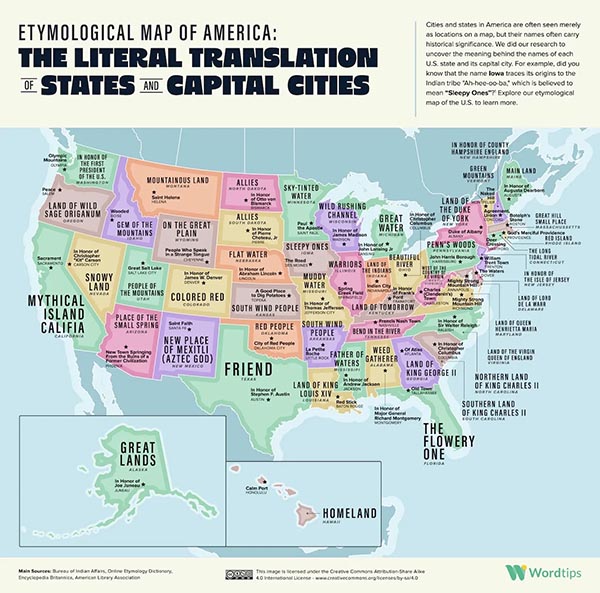
To specific regions:

Hmm…“Syracuse” means “To feel ill”? True, there have been some SU games… We had to get confirmation, and, says the Online Etymology Dictionary:
city in Sicily, founded as a Corinthian colony, and with a name traceable to 8c. B.C.E., from a pre-Hellenic word, perhaps Phoenician serah "to feel ill," in reference to its location near a swamp. The city in New York, U.S., was named 1825 for the classical city.
What’s the Phoenician word for “lake-effect snow”?
A Singular Talent
We were saddened to learn of the passing this week of science-fiction writer Vernor Vinge. Vinge won Hugo Awards for his novels A Fire Upon the Deep (1993), A Deepness in the Sky (2000), and Rainbows End (2007). In the latter, a favorite here in the AtW Bunker, an elderly technophobe awakens Rip Van Winkle-like to a world of AR, interconnected devices, and all-pervasive technology and struggles to make sense of it all. We feel like that some days.
Vinge was perhaps best known for writing and lecturing about the “singularity.” Says Ars Technica:
Vinge first coined the term “singularity” as related to technology in 1983, borrowed from the concept of a singularity in spacetime in physics. When discussing the creation of intelligences far greater than our own in an 1983 op-ed in OMNI magazine, Vinge wrote, “When this happens, human history will have reached a kind of singularity, an intellectual transition as impenetrable as the knotted space-time at the center of a black hole, and the world will pass far beyond our understanding.”
He was ahead of his time. Or we were behind his:
The singularity concept postulates that AI will soon become superintelligent, far surpassing humans in capability and bringing the human-dominated era to a close. While the concept of a tech singularity sometimes inspires negativity and fear, Vinge remained optimistic about humanity’s technological future, as Brin notes in his tribute: “Accused by some of a grievous sin—that of ‘optimism’—Vernor gave us peerless legends that often depicted human success at overcoming problems... those right in front of us... while posing new ones! New dilemmas that may lie just ahead of our myopic gaze. He would often ask: ‘What if we succeed? Do you think that will be the end of it?’”
His two “Deepness” novels are also great, sprawling space operas.
Everything Under the Sun Is in Tune…
As you may know, there is a truly exciting event coming up, one that doesn’t happen all that often. No, not drupa, but the Total Solar Eclipse of 2024, coming to the US Monday, April 8. NASA’s Eclipse Explorer lets you determine where and when in the country you can see the eclipse and at what level of totality.

We’ve got our glasses and we’re ready!

In addition to NASA, Atlas Obscura is your headquarters for all things eclipse, including “11 Spectacular Spots in Indiana to View the 2024 Eclipse,” “Space Makes Noise—And Here’s the Eerie Song an Eclipse Sings,” “Stephen King, Shakespeare, and Many Writers Agree: Eclipses Are Doom,” “Animal Behavior During a Total Solar Eclipse Is Wild,” and much much more.
And, via Food & Wine, the diner chain Sonic has introduced its Blackout Slush Float, which will be available starting March 25.
The all-black slush has what Sonic describes as a “sweet, cotton candy and dragon fruit flavor,” all blended together to represent the “temporary darkness from the solar eclipse.” It comes topped with soft serve and blue and purple galaxy-themed sprinkles to give it a true "out of this world" look.
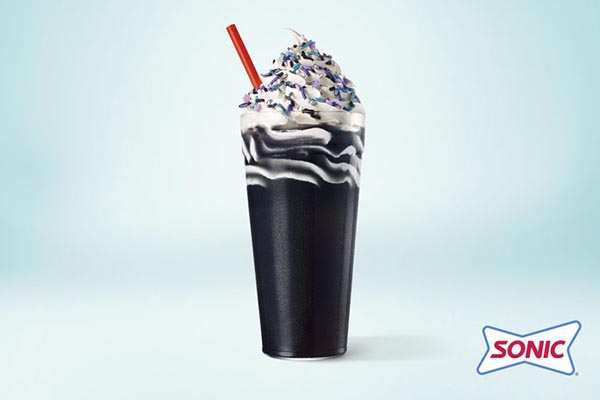
It’s worth nerding out over this eclipse because there won’t be another one viewable in the contiguous United States until 2044.
Built to Spill
You know how it is: you pour yourself a cup of coffee and as you are carrying it back to your desk, it inevitably sloshes over (or at least threatens to). Why does this happen? Via Laughing Squid, Sophie Abrahams of Oxford Sparks explains that it is because of resonance frequency.
The natural frequency of coffee in an average size mug is about 4 hertz, that’s 4 sloshes backwards and forwards per second. But the thing is, as you walk the forwards and backwards motion of your hand is also about 4 hertz.
However, Korean student Jiwon Han conducted a study in which he discovered how to avoid the sloshing.
Han suggested walking backwards or the claw grip could be used as ways to avoid spilling coffee. Walking backwards and the claw grip both change the way your body moves. Han proved that both of these methods change the motion of your hand to about 1.7 hertz.
Check it out:
For the Bird
Remember the “drinking bird”? Known by a number of different names—dunking birds, drinky birds, water birds, dipping birds, etc.—they were often seen in science classrooms, among many other places in the 1970s.
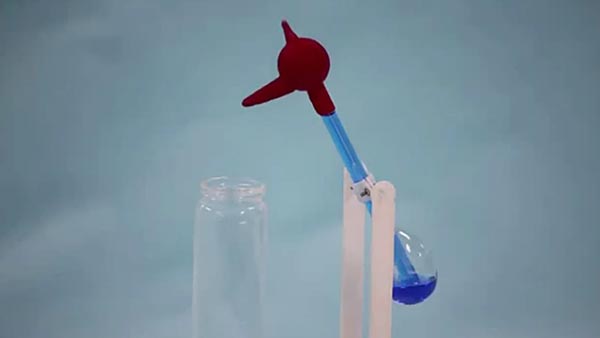
The physics behind it are relatively simple: The toy is made up of two glass bulbs, representing the head and body of the bird, which are connected by a long glass tube. Methylene chloride, a highly volatile liquid, is contained within the structure.
After the bird’s beak is dipped into a cup of water, it springs back into its natural upstanding position, and the water begins to evaporate and cool the head. This causes the volatile liquid from the lower bulb to rise up the tube, due to a difference in pressure, and as a result, the bird’s center of gravity begins to shift, tipping its beak back into the water.
They seem to have disappeared some time ago, but, via CNN, they could be poised for a comeback.
Scientists in Hong Kong and China have used the famous toy, also known as the “Dippy Bird,” to develop an engine capable of using the power of water evaporation to generate electricity, according to a study published Thursday in the journal Device.
The new method works by converting the energy produced by the bird’s characteristic back-and-forth movement into electrical power.
It’s actually a similar process to how the Earth’s water cycle works: sunlight heats the Earth’s surface, causing water from lakes and oceans to evaporate. “According to the study, this process uses up half the solar energy absorbed in the Earth’s surface and results in the ‘most significant amount of energy transfer on Earth.’”
If scientists can capture this energy and convert it into electricity, the authors say it could present “a substantial renewable energy opportunity.”
Lead author, Hao Wu, a professor at South China University of Technology, says that the drinking bird method offers a “unique” way to generate electricity using water, a “readily available fuel source.”
Basically, you convert evaporation energy into mechanical energy and then convert that into electricity, which is where the drinking bird idea comes in.
Wu and her colleagues added two nanogenerator modules — small devices which convert mechanical energy into electricity — to both sides of the bird’s “engine,” which was created from a commercial toy.
They then tested the prototype’s ability to power a range of electronics in ambient conditions, including liquid crystal displays (LCDs), temperature sensors and calculators. The idea is that one day the generator could be used in more commonly used everyday devices.
Until now, previous attempts to convert evaporation energy into electricity have suffered from a low-conversion efficiency. But using the drinking bird method, scientists have managed to generate an output of 100 volts using just 100 milliliters of water, enough to power small electronic devices.
Someday, we may be plugging our phones into the bird rather than just giving it one.
It’s a GO for Graphene
Was it a good week for graphene news? It’s always a good week for graphene news! Graphene may be safe to inhale—although the word “may” is a tad worrying. From (who else?) Graphene-Info The Graphene Council:
In a groundbreaking study published in Nature Nanotechnology, Andrews et al. conducted the first controlled investigation into the effects of inhaling graphene oxide nanosheets on human cardiovascular and pulmonary functions.
Remarkably, the results showed that acute inhalation of GO nanosheets did not induce detrimental effects on the participants’ health. This study holds significant implications, particularly for the rapid integration of GO into various commercial sectors. Previously, industries lacking facilities to handle nanopowders were limited to using GO in suspensions or masterbatches. However, this study provides confidence to the industry by demonstrating the safety of potential or incidental inhalation exposure to pure forms of GO, paving the way for its broader utilization.
For example, graphene-enhanced cocaine.
White Lights, White Heat
Some years ago, whilst tooling around the Northeast, we noticed a new kind of traffic light proliferating: a flashing amber left-turn arrow. At first, we were not quite sure what this meant (if they’re going to change traffic laws, they should make some kind of announcement), but after a while, we figured out that it meant that you could make a left turn if the oncoming lane was clear. (There may have been an announcement somewhere but we missed it.) At any rate, this was definitely a good idea.
Now it looks like there might be another change to traffic signals on the way: a fourth light—white. From NC State University News:
Adding a fourth light to traffic signals – in addition to red, green and yellow – would shorten wait times at street corners for pedestrians, as well as improve traffic flow for both autonomous vehicles and human drivers. And the more autonomous vehicles there are in the traffic network, the shorter the wait times for everyone.
Uh huh.
“Our earlier work introduced the idea of a fourth traffic signal called a ‘white phase,’ which taps into the computing power of autonomous vehicles (AVs) in order to expedite traffic at intersections – but we had not yet incorporated what this concept would mean for pedestrians,” says Ali Hajbabaie, corresponding author of the paper and an associate professor of civil, construction and environmental engineering at North Carolina State University. “We’ve now expanded our computational modeling to account for foot traffic, and the results are extremely promising for both pedestrians and vehicles.”
The white phase concept makes use of AVs’ ability to communicate wirelessly with both each other and the computers that control the traffic signals. When enough AVs are approaching the intersection, this would activate a new traffic light – the white light. While red lights mean stop, and green lights mean go, white lights tell human drivers to simply follow the car in front of them. In short, the white light is a signal that AVs are coordinating their movement to facilitate traffic through the intersection more efficiently.
What could possibly go wrong? Anyway, what about the pedestrians?
“We found that, when pedestrians are added into the mix, the white phase concept still improves traffic efficiency for everyone,” Hajbabaie says. “And, again, the higher the percentage of traffic that is made up of Avs, the more efficiently traffic moves through intersections.
Sure, they can mow the pedestrians down much more efficiently than a human driver could.
We remain unconvinced that as long as human-driven vehicles share the road with autonomous vehicles, it’s not going to be carnage.
You can read the full study here.
We should also point out that if you ever find yourself in the Tipperary Hill neighborhood of Syracuse, N.Y., you will encounter the world’s only upside-down traffic light:
The first traffic light at the intersection of Tompkins Street and Milton Avenue, one of the major intersections in the neighborhood was installed in the 1920s during the heyday of its Irish culture.
Some of the sons and grandsons of the Irish immigrants in the neighborhood couldn’t stand seeing the “British” red over the “Irish” green.
They fell ill?
Because of this, they broke the lights on the traffic signal with rocks that they dubbed “Irish confetti”. This is said to have continued happening over and over again as the city tried in vain to keep the stoplight in working order.
Finally, the city agreed to hang the light upside down, putting the green above the red. While the state attempted to keep this from happening, they eventually relented and, since 1928, the traffic light at Tompkins Street and Milton Avenue has been the only known green-above-red traffic light in the world.

Confusing? You bet!
Ryan Heir
Is your name Ryan? Do you wish it was? Would you like to meet other Ryans? If so, then good news! Via Boing Boing, you’ll not want to miss Ryan meetup, the largest gathering of Ryans in the world.
Run entirely by Ryans, for Ryans (And, on occasion, Rians and Ryanns, so long as they pronounce their names “Ryan”). Three Ryans in New York have made it their business to put as many Ryans in the same room as possible, all across the US. So far, they’ve had a Ryan meetup at Ryan Maguire’s Bar in New York, a Ryan rodeo in Austin, and a Ryan rave in Los Angeles, featuring six Ryan DJs, Ryan-run vending, and paperwork for the dozen people there who weren’t named Ryan to legally change their names to Ryan.

Do you even need the name tags?
So…why?
Ryan Rose had a tough time making friends in New York City. She founded two different meetup groups, one for paranormal research and one for horror movie fans.
One could draw a pretty meaty Venn diagram from those two groups, wethinks.
Despite the common interests, the groups didn't go anywhere. She had to turn to some commonality more permanent and whimsical. Something that people could take pride in, something easy.
So, she started alone, flyering telephone poles in Brooklyn. “Is your name Ryan? Wanna meet other Ryans?” Two additional Ryans showed up, Ryan Cousin and Ryan Le. The three of them founded the Ryan Meetup, which now has a website, merch, events, and is angling to break a world record for the largest same name gathering in the world, an honor currently held by Ivan and attempted by Kyle.
Probably a much smaller group would be people named Ryan who are paranormal researchers who love horror movies. If you wanted to get really niche.
You can learn more about Ryan(s) here (don’t even think of clicking if your name is Bryan—they’ll have none of that). There is also an interactive map where you can see if there’s a Ryan in your town. (Now we’re getting into a whole weird area.) If you are in Chicago, there is a brand new St. Ryan’s Day holiday on March 23.
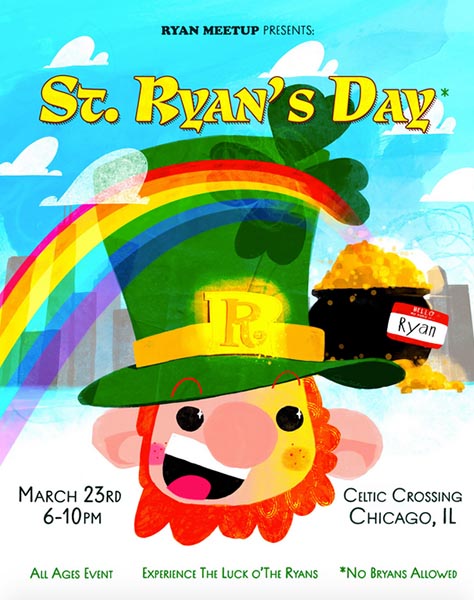
Too bad Ryan O’Neal recently passed away. He could have keynoted.
Sharper Image Catalog
Have you ever had an item confiscated by TSA? That Swiss Army knife, nailclipper, or bullet keychain you inadvertently had in your pocket or carry on? (We once had a large-ish tube of toothpaste confiscated. TSA offered to check it as baggage and it would have been worth it to just to watch it come down the baggage carousel at the destination airport, which would have been hysterical. Anyway…)
If you thought you’d never see your confiscated item again, you may want to head out to Austin, Tex., where apparently there is a store where items that have been surrendered to TSA have ended up and are being sold. Via Boing Boing, it is called the State Surplus Store.
Operated by the Texas Facilities Commission, the store gets new items daily. Its inventory, sourced in bulk from the TSA, comes from major airports in Houston, Dallas, and Fort Worth. The revenue generated from selling these items is reinvested into state and federal surplus programs, making it a cost recovery effort.
This store is open to the public, so someone's security-checkpoint loss could be your gain. It’s kind of like a thrift store for prohibited stuff that didn't make the flight. And deals are definitely a-plenty.
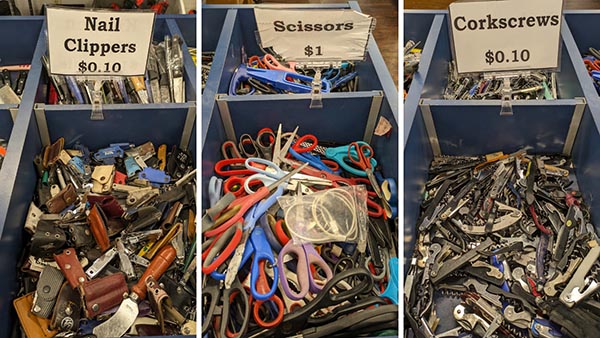
Maybe that’s where the toothpaste ended up.
Of Thee Icing
Two weeks ago, we mentioned Kith’s “Fruity Pebbles sneakers”—about which a friend of ours wrote in to say that his son has a pair of them and loves them, actually—and the weird partnership between food and footwear continues. This time, it’s Keds and Magnolia Bakery. Via Food & Wine:
On Thursday, the shoe brand announced its partnership with Magnolia Bakery, bringing everyone some adorable
Well…
limited-edition footwear. According to Keds, the collaboration features three styles and blends together “signature Magnolia Bakery details like confetti sprinkles, pastel-hued frosting, and flower cupcake decorations” with the unmistakable Keds silhouette.
The line includes the “Champion in Glitter,” which uses the Keds Champion design, a design that debuted way back in 1916 and has been a staple of the brand ever since. The canvas, lace-up sneaker features multi-colored glitter in mint green, blush, and gold on the upper and Magnolia’s signature mint green color on the outsoles. Even the inside of the shoe is cool, as it sports an adorable sprinkle print, along with a dash of gold on the sneaker’s rivets for the perfect touch. The sneaker even comes with a removable “Carrie cupcake” charm, because, well, why not?
“Carrie cupcake”? Is it filled with pig’s blood? Or are we thinking of the wrong Carrie?

“You got your sneaker in my cake!” “No, you got your cake on my sneaker!” We’re not sure this was the best promotional photo they could have taken.
The collection is $80 per style and is available at keds.com and select retailers. Cakes not included, which seems a bit unfair.
This Week in Printing, Publishing, and Media History
March 18
1733: German author and bookseller Christoph Friedrich Nicolai born.
1768: Irish novelist and clergyman Laurence Sterne dies (b. 1713).
1850: American Express is founded by Henry Wells and William Fargo.
1932: American novelist, short story writer, and critic John Updike born.
1961: American singer-songwriter and guitarist Grant Hart born.
March 19
1813: Scottish missionary and explorer David Livingstone born, we presume.
1895: Auguste and Louis Lumière record their first footage using their newly patented cinematograph.
1928: Irish-American actor, director, producer, and screenwriter Patrick McGoohan born. Be seeing you.
1931: Gambling is legalized in Nevada. (What are the odds it’ll catch on?)
1933: American novelist Philip Roth born.
1962: Bob Dylan releases his first album, Bob Dylan.
2008: British science fiction writer Arthur C. Clarke dies (b. 1917).
March 20
43 BC: Roman poet Ovid born.
1828: Norwegian poet, playwright, and director Henrik Ibsen born (not in a doll’s house).
1852: Harriet Beecher Stowe’s Uncle Tom’s Cabin is published.
1896: With the approval of Emperor Guangxu, the Qing dynasty post office is opened, marking the beginning of a postal service in China.
1915: Albert Einstein publishes his general theory of relativity.
1922: American actor, director, producer, and screenwriter Carl Reiner born.
1923: The Arts Club of Chicago hosts the opening of Pablo Picasso's first United States showing, entitled Original Drawings by Pablo Picasso, becoming an early proponent of modern art in the United States.
1948: With a Musicians Union ban lifted, the first telecasts of classical music in the United States, under Eugene Ormandy and Arturo Toscanini, are given on CBS and NBC.
1950: English drummer, percussionist, and songwriter Carl Palmer born.
1964: Irish republican and playwright Brendan Behan dies (b. 1923).
March 21
1952: Alan Freed presents the Moondog Coronation Ball, the first rock and roll concert, in Cleveland, Ohio.
2006: The social media site Twitter is founded.
March 22
1765: The British Parliament passes the Stamp Act that introduces a tax to be levied directly on its American colonies. (Spoiler alert: it didn’t go well.)
1832: German novelist, poet, playwright, and diplomat Johann Wolfgang von Goethe dies (b. 1749).
1887: American actor Chico Marx born. (Why a duck?)
1931: Canadian actor William Shatner born.
2020: Indian Prime Minister Narendra Modi announces the country's largest ever self-imposed curfew, in an effort to fight the spread of COVID-19.
March 23
1842: French novelist Stendhal (né Marie-Henri Beyle) dies (b. 1783).
1857: Elisha Otis’s first elevator is installed at 488 Broadway New York City.
1910: Japanese director, producer and screenwriter Akira Kurosawa born. (Everyone who witnessed his birth described it differently.)
1965: NASA launches Gemini 3, the United States’ first two-man space flight (crew: Gus Grissom and John Young).
March 24
1693: John Harrison, English carpenter and clock-maker, invented the Marine chronometer. (Harrison was the subject of Dava Sobel’s excellent book Longitude.)
1721: Johann Sebastian Bach dedicated six concertos to Margrave Christian Ludwig of Brandenburg-Schwedt, now commonly called the Brandenburg Concertos, BWV 1046–1051.
1834: English textile designer, poet, and author William Morris born.
1874: Hungarian-Jewish American magician and actor Harry Houdini (né Ehrich Weiss) escaped from the womb.
1882: American poet and educator Henry Wadsworth Longfellow dies (b. 1807).
1905: French novelist, poet, and playwright Jules Verne dies (b. 1828).
1909: Irish playwright and poet John Millington Synge dies (b. 1871).
1907: The first issue of the Georgian Bolshevik newspaper Dro is published.
1949: English singer-songwriter, bass player, and producer Nick Lowe born. And so it goes.
1958: Elvis Presley is drafted in the U.S. Army.















Discussion
Join the discussion Sign In or Become a Member, doing so is simple and free